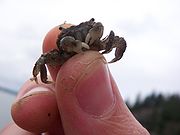Hemigrapsus oregonensis
From marinelife1011
| Hemigrapsus oregonensis | |
|---|---|
 |
|
| Yellow shore crab found at the Evergreen beach | |
| Scientific classification | |
| Kingdom: | Animalia |
| Phylum: | Arthropoda |
| Subphylum: | Crustacea |
| Class: | Malacostraca |
| Order: | Decapoda |
| Infraorder: | Brachyura |
| Family: | Varunidae |
| Genus: | Hemigrapsus |
| Species: | H. oregonensis |
| Binomial name | |
| Hemigrapsus oregonensis (Dana, 1851) |
|
Hemigrapsus oregonensis
Contents |
Description
These Yellow shore crabs vary in sizes they typically range from 1 3/8" (35mm) wide, to 1 1/4" (32mm) long. They have rounded bodies, with the upper carapace a yellow to green color. Olive-green black color hairs (setae) on its legs. Mottled with brownish-purple or black, some have been seen dark or grayish green in color, but white or mottled patterns are the most common, especially among juveniles; pincer tips are usually yellow to white.[1][2] There are often times 3 teeth anterolateral on the carapace. This species is a better osmoregulator than the other local shore crabs (Hemigrapsus nudus), which is probably associated with its being more common in estuaries. It also often digs burrows and is capable of withstanding more hypoxic conditions than the other shore crabs are.
Habitat
They normally are found among muddy,sandy and most often gravelly areas. They are very fast burrowers who often burrow under rocks for protection. They are found mostly in intertidal regions. Generally, prefers more protected and slow water current areas. H. nudus have been seen together with H. oregonensis. [3] [1]
Feeding
Feeding mostly at night, they primarily eat diatoms and green algae. Can also occasionally prey on meat if available. Preys on a wide variety of small invertebrates when available, it scavenges when possible. Can also filter-feed by using its third maxillipeds (an appendages that's modified to act as mouthparts). [4][5]
Predators
Predators include shorebirds and Carcinus maenas (a common littoral crab, and an important invasive species, listed among the 100 "world's worst alien invasive species")[6][7]. A type of red ribbon worm is also a predator of the eggs of H. oregonensis.
Behavior
Mostly active during the night when they feed, by day, these crabs remain hidden under debris or in burrows they have excavated, which may be especially conspicuous in the muddy banks of tidal ditches. [8] Often times they can be seen briefly when turning over rocks but quickly burrow down to safety in the sand. H. oregonensis ranges from the high to low in intertidal zones of bays and estuaries and beaches from Resurrection Bay (Alaska) to Bahia de Todos Santos (Baja California). This species is very abundant under stones in the mud along the shores, and in mud burrows in the banks of various estuaries in the region. The high tolerance of this specific shore crab (H. oregonensis) is in lower salinity and turbid waters, which allow for it to dominate particular areas in this case in bays and brackish water situations. [9]
Reproduction
In a study on the reproductive cycle of H. oregonensis in Oregon, (at the Oregon State Universty) the major reproductive cycle season, was determined by the number of egg-bearing females collected, which was from February to May. Maximum brooding was in March, minimum brooding during October. Different brooding periods were identified in studies in other parts of this crab's range. (Batie 1982)[10] In northern waters ovigerous females are seen from February to September. The number of eggs carried by the female is ranged from 100 to 11,000 (with an average number of 4,500). Hatching occurs from May to July with one pre-zoeal stage occurring inside the egg. Planktonic larvae develop through five post-hatching zoeal stages. The larvae typically spend five weeks in the plankton. In August some females produce a second brood which hatches in September. Time from egg deposition to adult recruitment is variable and depends on several factors: the quantity and quality of food available, water temperature and salinity. Altogether it takes about 8-13 weeks for a brood to hatch, metamorphose and be recruiting into the adult population.[8] [5]
Additional reading
http://www.jstor.org/stable/1353480 (The Impact of Yellow Shore Crabs, Hemigrapsus oregonensis, on Early Benthic Phase Dungeness Crabs, Cancer magister, in Intertidal Oyster Shell Mitigation Habitat), Eileen P. Visser, P. Sean McDonald and David A. Armstrong.
http://www.springerlink.com/content/w01858x41736w567/ (Factors influencing the distribution and coexistence of Pachygrapsus crassipes and Hemigrapsus oregonensis (Decapoda: Grapsidae) in a California salt marsh), S. W. Willason
http://www.esajournals.org/doi/abs/10.2307/1936110 (Behavioral Responses of the Crab Hemigrapsus Oregonensis to Temperature, Diurnal Light Variation and Food Stimuli)
http://people.oregonstate.edu/~yamadas/crab/ch5.htm (Life History of the native shore crabs Hemigrapsus oregonensis and Hemigrapsus nudus and their distribution, relative abundance and size frequency distribution at four sites in Yaquina Bay, Oregon).
http://eco.confex.com/eco/2009/techprogram/P19628.HTM (Selective predation of Pachygrapsus crassipes and Hemigrapsus oregonensis on the California horn snail, Cerithidea californica in the laboratory)
References
- ↑ 1.0 1.1 Norman A. Meinkoth National Audubon Society Field Guide to Seashore Creatures, Alfred A. Knopf New York (1981).
- ↑ Jennifer Telnack, Melissa Phipps, Intertidal Marine Invertebrates of the South Puget Sound http://www.nwmarinelife.com/htmlswimmers/h_oregonensis.html
- ↑ Dave Cowles (2005), http://www.wallawalla.edu/academics/departments/biology/rosario/inverts/Arthropoda/Crustacea/Malacostraca/Eumalacostraca/Eucarida/Decapoda/Brachyura/Family_Grapsidae/Hemigrapsus_oregonensis.html
- ↑ http://en.wikipedia.org/wiki/Decapod_anatomy
- ↑ 5.0 5.1 Kozloff, E. N. (1993).Seashore Life of the Northern Pacific Coast, 3rd printing (with corrections). Seattle: University of Washington Press. http://www.racerocks.com/racerock/eco/taxalab/2005/hemigrapsuso/hemigrapsuso.htm
- ↑ 100 of the World's Worst Invasive Alien Species http://www.issg.org/database/species/search.asp?st=100ss&fr=1&sts= publisher Invasive Species Specialist Group
- ↑ http://en.wikipedia.org/wiki/Carcinus_maenas
- ↑ 8.0 8.1 Leo, Shapiro (2010), http://eolspecies.lifedesks.org/pages/21239
- ↑ Brusca, G. J., & Brusca R. C. (1978). A Naturalist's Seashore Guide. Eureka, California: Mad River Press.
- ↑ Batie, R. E. (1982).Population Structure of the Crab H. oregonensis (Brachyura, Grapsidae) in Yaquina Bay Estuary, Oregon: l. Reproductive Cycle. Northwest Science. 56, 20-26.


